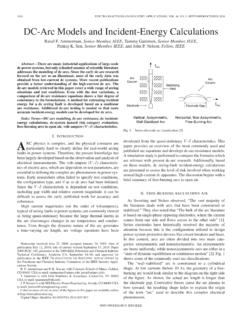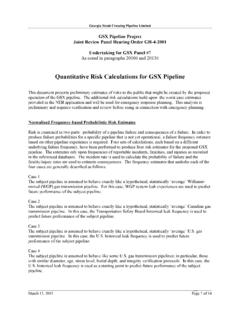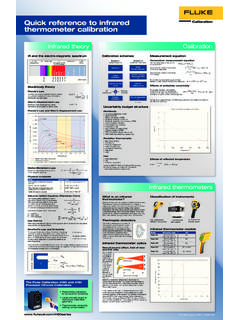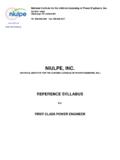Transcription of Chapter 4. Microwave Scattering from the Sea
1 117 Chapter 4. Microwave Scattering from the SeaDonald R. ThompsonJohns Hopkins University Applied Physics Laboratory, Laurel, Maryland IntroductionThere is at present considerable interest in achieving a better understanding of the physicsthat governs the Scattering of Microwave radiation from the sea. This interest is due in large partto the rapid advances in ocean remote sensing using Microwave techniques during the past twodecades or so. These advances were triggered by the extremely rich and varied data setscollected by Microwave sensors on numerous spaceborne satellite missions undertaken duringthis period.
2 The Microwave instrumentation flown on these missions included synthetic apertureradar (SAR), wind scatterometers, and altimeters. Additional missions with advancedmicrowave sensors are planned for launch in the near future. As these missions proceed andanalysis of the data progresses, the operational use of Microwave radar for the estimation ofuseful geophysical parameters should become order to extract geophysical information from the data collected by microwavesensors, it is clear that one must understand not only the Scattering physics, but also surface wavehydrodynamics and the structure of the marine boundary layer.
3 In particular, a method forcharacterizing the shape of the sea surface (and perhaps even its evolution) is necessary in orderto properly apply the electromagnetic boundary conditions. A convenient way to proceed withthis characterization is through the surface-height spectral density. Thus, we begin this chapterby presenting a general description of rough-surface Scattering based on knowledge of thesurface spectrum. This description will motivate the more general discussion of spectralmodulation by wind fluctuations and spatially varying current fields that BackgroundPerhaps the most common example of electromagnetic Scattering is that from acompletely flat horizontal interface between free space and another medium with relativedielectric constant r and relative permeability r.
4 (For conducting media such as the ocean, r isa complex number whose imaginary part is related to the conductivity, and for most commonmaterials, r is of order unity.) It is a standard problem in electrodynamics to apply the boundaryconditions on the electric and magnetic fields at the interface to obtain the Fresnel reflection andtransmission coefficients [ , Jackson, 1997]. As expected, one finds that a portion of theincident field is reflected at the interface in the plane defined by the incident wavenumber andthe surface normal vector (called the plane of incidence) along a direction such that the angle ofreflection equals the angle of incidence (like an ordinary mirror).
5 This process is sometimescalled specular reflection. The remaining portion of the incident field is transmitted into themedium (also in the plane of incidence) along a direction defined by the familiar Snell s law. Aschematic of the situation is shown in Figure The top panel shows the case when theincident electric field is in the plane of incidence, while in the bottom panel, the incident E fieldis perpendicular to the incident plane. The former case is commonly referred to as verticalpolarization, the latter is horizontal polarization. The Fresnel coefficients are generally differentfor the two cases.
6 Note that for both cases, the directions of the electric field vector ( r E ), theSAR Marine User s Manual118 Figure Reflection and refraction from a plane interface where the lower medium has relative dielectric constant r and relative permeability r. The top panel shows the field orientation when the incident electric field is in theplane of incidence (Vertical Polarization). In the bottom panel, the E field is perpendicular to (directed into) theplane of incidence (Horizontal Polarization).magnetic field vector ( r B ), and the direction of propagation ( r k ) are mutually orthogonal andsatisfy the relation E B = k.
7 The strength of the transmitted field is attenuated as it penetratesinto a conducting medium. For sea water, the skin depth (distance where the intensity falls toe-1 of its initial value) of Microwave radiation is about cm for a frequency of 1 GHz (30-cmwavelength) and cm for 10 GHz (3-cm wavelength). For a perfect conductor, there is nopenetration into the medium, and all the incident energy is reflected from the interface for bothpolarization states regardless of the angle of Scattering from the Sea119As seen above for the special case of a smooth flat surface, the incident energy isreflected into the specular direction (or dissipated in the medium).
8 Thus a monostatic radarsystem, which transmits and receives using a single antenna, will receive no (backscattered)signal from such a surface. The sea surface, of course, is not smooth and flat. Its roughnessspectrum can span scales covering more than five decades; from several hundred-meter swellwaves, through wind-generated waves with wavelengths ranging from several tens of meters to acentimeter or so, to short capillary waves with wavelengths of only a few millimeters. Since theroot-mean-square (rms) slope of the sea surface is generally small, most incident electromagneticradiation is still scattered in the specular direction.
9 The presence of the surface roughnesshowever causes a small amount of the incident radiation to be scattered into all other directions;in particular back toward the transmitting antenna (in the backscatter direction).An accurate description of Microwave Scattering from the sea is therefore considerablymore complicated than for the case of the smooth flat interface discussed above. In particular,the complicated nature of the sea-surface roughness spectrum renders proper application of theelectromagnetic boundary conditions quite difficult. We turn our attention now to a discussionof methods for handling this rough surface Scattering problem and implications of these methodson the interpretation of Microwave remote-sensing Scattering from a Rough SurfaceAll available closed- form models for electromagnetic Scattering from rough surfaces areasymptotic approximations to an exact solution of Maxwell s equations.
10 The two mostcommonly used models are the Kirchhoff approximation [Beckmann and Spizzichino, 1963] andthe small perturbation method (SPM) [Ulaby et al., 1982]. The Kirchhoff approximation is validfor small slopes and long wavelengths. It correctly models quasi-specular Scattering , but lackspolarization sensitivity. The SPM is valid for small slopes and short wavelengths. It yields theproper polarization sensitivity for this regime, but does not properly account for long-scalefeatures in the surface spectrum and does not account for specular Scattering . Recently, apopular approach has been to investigate successive iterations of the so-called surface-currentintegral equation in order to find a model that is correct for both of the above limits.



